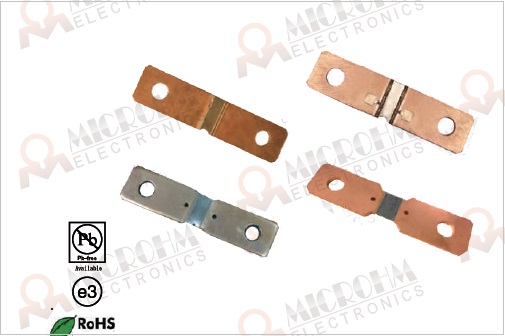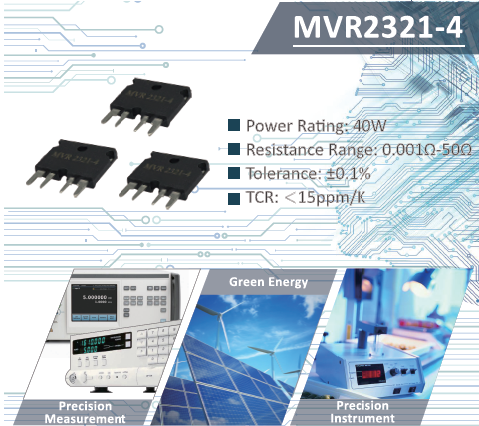Position:Home » Technical Articles
Kelvin Resistors for Current sensing
Writer:Microhm Page View:Date:2019-12-16
When designing power supplies and regulated battery circuits, the aim is to eliminate the risk of short circuits or over current conditions which are likely to damage other components. Microhm Electronics' current sense resistors are the simple and economic solution for these applications.
What is a current sense resistor?
Current sensing products are established industry favorites among resistive products. A majority of current sense resistors are surface mount, as is true with most passive products. Current sense resistors are often referred to as 'shunt' resistors, such as MPR sereis, MMS8420 and MVR2321-4C of Microhm Electronics. Shunt resistors are used to monitor the amount of current that is flowing through a circuit. Such resistors have very low resistance values, typically less than 50 milli-ohms (0.050 ohms) and often lower.

How do they work?
As stated by Ohm's law, there is a voltage drop across any resistance when current is flowing. This voltage drop is measure across the low value and converted to a current value. As a result, the calibrated resistance senses the current flow through the resistor in the form of a voltage drop which is detected and monitored by the control circuitry. A current sensing resistor is designed for low resistance so as to minimize power consumption.
What is a ' Kelvin' configuration?
A 'Kelvin' configuration resistor features four leads or terminations. These four terminal resistors enable current to be applied through two opposite leads and a sensing voltage to be measured across the other two leads. The Kelvin configuration effectively eliminates the resistance and temperature coefficient of the leads. The Kelvin connection can also simplify board design by incorporating all terminals for the sensing circuit into one part. A Kelvin connection is essential for accurate current sensing and simplified board design.
Current measurement using a shunt resistor and voltmeter is particularly well-suited for applications involving particularly large magnitudes of current. In such applications, the shunt resistor's resistance will be in the order of milli-ohms or micro-ohms, so that only a modest amount of voltage will be dropped at full current. The resistance of some shunts can be so low that it is comparable to wire connection resistance. Measuring the voltage drop across a shunt with such low values must be done in a way as to avoid detecting voltage dropped across the current carrying wire connections. Shunts are usually equipped with four connection terminals. Using a shunt this way ensures the voltmeter only measures the voltage dropped by the shunt resistance itself, without any stray voltage drops or resistance originating from wire or connection.

Where can they be used?
There are a multitude of uses for this product. Some examples of applications are general use, consumer goods, automotive ,telecom
medical and instrumentation and military and aerospace.
What does the future hold?
As the world becomes increasely technology driven, the uses for current sensing resistors will continue to increase. The need for smaller size, lower resistance, higher power resistors is becoming evident. Manufactures, like Microhm Electronics, are dedicated to R&D number of new resistors to meet these requirements.
Keywords:Kelvin Resis
Latest News
- Resistor's role in measuring and correcting LED,,,
- Single through-hole resistors' characteristics ,,,
- Why shunt resistors for current sense applicati,,,
- Metal-film resistors with small size, high resi,,,
- 36W High-Current Shunt Resistors MMS8420,,,
- 1W Surface Mount Resistor MPR1206,,,
- An Overview of Microhm Electronics' Resistor Pr,,,
- More anti-sulfur resistors used in harsh envir,,,
- Resistance changes with temperature,,,
- 140W TO247 High Power Heatsinkable Resistor,,,
- MMS5930 is ideal for current sensing in industr,,,
- Shunt resistors selection for engineers' design,,,
- Considerations for choosing precision resistors,,,
- Ceramic Encased Cement Resistors NWH Series for,,,
- Resistors for Passive Balancing in Battery-Pow,,,
Hot Articles
- Microhm will take part in 10th Automotive World,,,
- Thanks for Visiting Microhm's Booth E5-5706 in ,,,
- Resistors in Short Supply: Blame Cars,,,
- New lunch: High Power Precision Shunt Resistor,,,,
- How to Test a Resistor,,,
- Innovative Technology, Future Electric: Electri,,,
- What is Precision Resistors?,,,
- SMD Resistors Sizes and Packages,,,
- The Construction and Features of Metal Film Res,,,
- What is a TO-220 Resisor?,,,
- Hot Selling Products: Precision Shunt Resistors,,,
- How to Calculate the Equivalent Resistance Valu,,,
- What is a Fixed Resistor?,,,
- Resistors in LED Circuits,,,
- Resistors Types and Materials Overview,,,
Resistance applications
- Why Zero-Ohm Resistors?,,,
- Difference Between High Precision Resistors and,,,
- The Measurement Accuracy of Automotive Shunt is,,,
- The Main Application for High Precision and Low,,,
- Industrial Roberts Applied to Solar Photovoltai,,,
- Urbanization Development Bringing the Transform,,,
- Precision Resistors' Construction and TCR,,,
- BMS for New Energy Vehicle,,,
- The Four Important Functions of Alloy Resistors,,,
- Heater Blower Motor Resistor in Air Conditioner,,,
- Select the Right Resistor for Harmonic Filterin,,,
- Surface Mount Resistor's Size and Package ,,,
- Carbon Film Resistors' Features and Application,,,
- Shunt Resistor MMS8420 for High Current Stable ,,,
- Miniature future for passive electronic compone,,,
